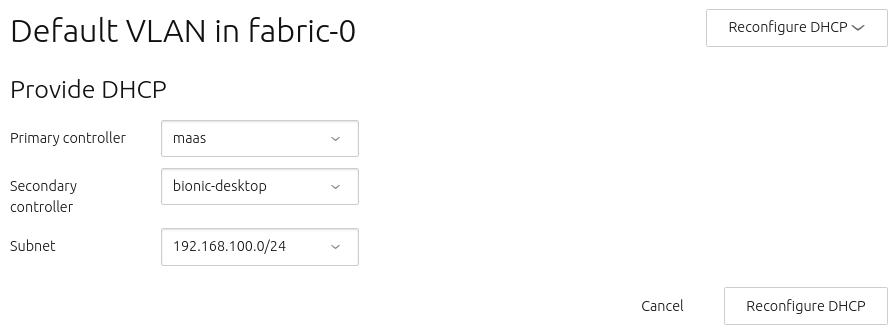High Availability
This page describes how to provide high availability (HA) for MAAS at both the rack-controller level and the region-controller level. See Concepts and terms for detailed information on what services are provided by each of those levels.
Rack controller HA
Multiple rack controllers are necessary to achieve high availability. Please see Rack controller to learn how to install rack controllers.
Multiple region endpoints
MAAS will automatically discover and track all reachable region controllers in a single cluster as well as automatically attempt to connect to them in the event that the one being used becomes inaccessible.
Administrators can alternatively specify multiple region-controller endpoints
for a single rack controller by adding entries to /etc/maas/rackd.conf.
E.g.
. . . maas_url: - http://<ip 1>:<port>/MAAS/ - http://<ip 2>:<port>/MAAS/ . . .
BMC HA
HA for BMC control (node power cycling) is provided out of the box once a second rack controller is present. MAAS will automatically identify which rack controller is responsible for a BMC and set up communication accordingly.
DHCP HA
DHCP HA affects node management (enlistment, commissioning and deployment). It enables a primary and a secondary DHCP instance to serve the same VLAN where all lease information is replicated between rack controllers. MAAS-managed DHCP is a requirement for DHCP HA.
If you are enabling DHCP for the first time after adding a second rack controller, please read Enabling DHCP.
However, if you have already enabled DHCP on your initial rack controller, you'll need to reconfigure DHCP. Simply access the appropriate VLAN (via the 'Subnets' page) and choose action 'Reconfigure DHCP'. There, you will see the second rack controller in the 'Secondary controller' field. All you should have to do is press the 'Reconfigure DHCP' button:

The setup of rack controller HA is now complete.
Note: For HA purposes, DHCP provisioning will take into account multiple DNS services when there is more than one region controller on a single region.
Region controller HA
Implementing region controller HA involves setting up:
- PostgreSQL HA
- Secondary API server(s)
Load balancing is optional.
PostgreSQL HA
MAAS stores all state information in the PostgreSQL database. It is therefore recommended to run it in HA mode. Configuring HA for PostgreSQL is external to MAAS. You will therefore need to study the PostgreSQL documentation and implement the variant of HA that you feel most comfortable with.
A quick treatment of PostgreSQL HA: hot standby is provided here for convenience only. Its purpose is to give an idea of what's involved at the command line level when implementing one particular form of HA with PostgreSQL.
Note: Each region controller uses up to 40 connections to PostgreSQL in high load situations. Running 2 region controllers requires no modifications to the max_connections in postgresql.conf. More than 2 region controllers requires that max_connections be adjusted to add 40 more connections per extra region controller added to the HA configuration.
Secondary API server(s)
Please see Region controllers and Multiple region endpoints for more information about how to install and configure rack controllers for multiple region controllers.
Load balancing with HAProxy (optional)
Load balancing can be added with HAProxy load-balancing software to support multiple API servers. In this setup, HAProxy provides access to the MAAS web UI and API.
Note: If you happen to have Apache running on the same server where you intend to install HAProxy, you will need to stop and disable apache2, because HAProxy binds to port 80.
Install
sudo apt install haproxy
Configure
Configure each API server's load balancer by copying the following into
/etc/haproxy/haproxy.cfg (see the
upstream configuration manual
as a reference). Replace $PRIMARY_API_SERVER_IP and $SECONDARY_API_SERVER_IP
with their respective IP addresses:
frontend maas bind *:80 retries 3 option redispatch option http-server-close default_backend maas backend maas timeout server 90s balance source hash-type consistent server localhost localhost:5240 check server maas-api-1 $PRIMARY_API_SERVER_IP:5240 check server maas-api-2 $SECONDARY_API_SERVER_IP:5240 check
Where maas-api-1 and maas-api-2 are arbitrary server labels.
Now restart the load balancer to have these changes take effect:
sudo systemctl restart haproxy
The configuration of region controller HA is now complete.
The API server(s) must be now be referenced (e.g. web UI, MAAS CLI) using port 80 (as opposed to port 5240).
Snap
Setting up high-availability using snaps is relatively easy. To use snaps instead of a package distribution of MAAS:
- Set up PostgreSQL for high-availability as explained above. PostgreSQL should run outside of the snap.
- Install the MAAS snap on each machine you intend to use as a
rack or region controller. You'll need the MAAS shared secret, located here,
/var/lib/maas/secret, on the first region controller you set up. - Initialise the snap as a
rackorregioncontroller. Note that if you intend to use a machine as a region controller, you'll need to tell MAAS how to access your PostgreSQL database host with the following arguments:--database-host DATABASE_HOST--database-name DATABASE_NAME--database-user DATABASE_USER--database-pass DATABASE_PASS
VIP
Note that in previous versions of MAAS, a virtual IP was required to serve as the effective IP address of all region API servers in high-availability environments. Since MAAS 2.5, this is no longer required. See Virtual IP for more information.
